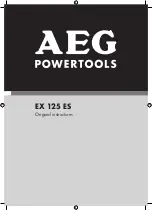
5
EN
Technical data
Mains voltage
220-240 V~
Mains frequency
50 Hz
Power input
350W
No-load speed
13.000/min
Sanding surface
93 x 185 mm
Weight
1.86 kg
NOISE AND VIBRATION
Sound pressure (L
pa
)
75.1 db(A) K=3dB
Acoustic power (L
wa
)
86.1 db(A) K=3dB
Vibration
4.184 m/s
2
K=1.5m/s
2
Wear hearing protection.
Vibration level
The vibration emission level stated in this
instruction manual has been measured in
accordance with a standardised test given in
EN 60745; it may be used to compare one tool
with another and as a preliminary assessment of
exposure to vibration when using the tool for the
applications mentioned
- using the tool for different applications, or with
different or poorly maintainted accessories,
may significantly increase the exposure level
- the times when the tool is switched off or when
it is running but not actually doing the job, may
significantly reduce the exposure level
Protect yourself against the effects of vibration by
maintaining the tool and its accessories, keeping
your hands warm, and organizing your work
patterns
DESCRIPTION (FIG. A)
Your finishing sander has been designed for
sanding wood, metal, plastics and painted
surfaces.
1. On/off switch
2. Lock-on button
3. Sanding pad
4. Sanding paper clamp
5. Grip
6. Dustbag connection
ASSEMBLY
Before assembly, always switch off the
machine and remove the mains plug from
the mains.
Mounting and removing the sanding paper
(Velcro
®
system) (fig. B)
Mounting
• Mount sanding paper (7) with the required
grain size onto the sanding pad (3). Make
sure that the perforation in the sanding paper
(7) corresponds with the perforation on the
sanding pad (3).
Removing
• Remove the sanding paper (7) from the
sanding pad (3).
Mounting and removing the sanding paper
(sanding paper clamps) (fig. C)
Mounting
• Open the sanding paper clamps (4).
• Mount sanding paper (7) with the required
grain size onto the sanding pad (3). Make
sure that the perforation in the sanding paper
(7) corresponds with the perforation on the
sanding pad (3).
• Fold the sanding paper (7) at both ends around
the edges of the sanding pad (3).
• Close the sanding paper clamps (4) one by
one. Make sure that the ends of the sanding
paper (7) are clamped.
Removing
• Open the sanding paper clamps (4).
• Remove the sanding paper (7) from the
sanding pad (3).
• Close the sanding paper clamps (4).
USE
Switching on and off (fig. A)
• To switch on the machine, press the on/off
switch (1).
• To switch the machine to continuous mode,
keep the on/off switch (1) pressed and
simultaneously press the lock-on button (2).
• To switch off the machine, release the on/off
switch (1).
Summary of Contents for PSM1029P
Page 2: ...2 Fig B Fig A 3 7 6 2 1 5 3 4 4 ...
Page 3: ...3 Fig D Fig C 6 8 4 3 4 7 ...
Page 89: ...89 ...
Page 90: ...90 ...
Page 91: ...91 ...
Page 94: ...94 ...






































